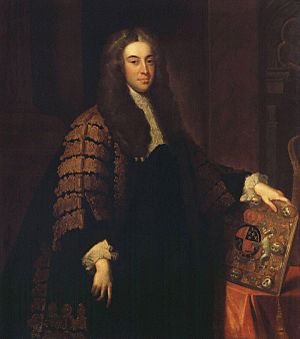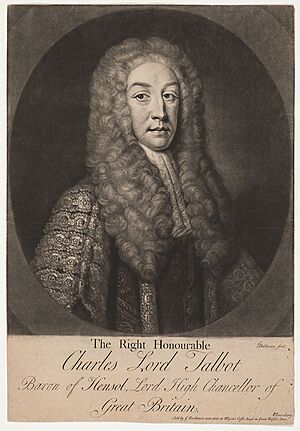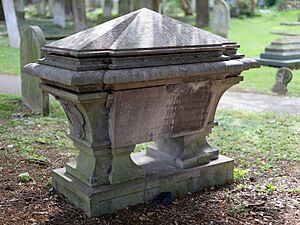Charles Talbot, 1st Baron Talbot facts for kids
Quick facts for kids
The Lord Talbot
|
|
|---|---|

Portrait by John Vanderbank
|
|
| Lord High Chancellor of Great Britain | |
| In office 29 November 1733 – 14 February 1737 |
|
| Monarch | George II |
| Prime Minister | Sir Robert Walpole |
| Preceded by | The Lord King |
| Succeeded by | The Earl of Hardwicke |
| Personal details | |
| Born | 1685 |
| Died | 14 February 1737 Lincoln's Inn Fields |
| Education | Eton College |
| Alma mater | Oriel College, Oxford |
Charles Talbot, 1st Baron Talbot (1685 – 14 February 1737) was an important British lawyer and politician. He held a very high position as the Lord High Chancellor of Great Britain from 1733 to 1737. This role meant he was the head of the legal system in Britain.
Contents
Charles Talbot's Early Life and Education
Charles Talbot was the oldest son of William Talbot, who was a Bishop of Durham. His family was connected to the 1st Earl of Shrewsbury, a famous historical figure.
Charles went to Eton College, a well-known school. After that, he studied at Oriel College, Oxford, and became a fellow at All Souls College in 1704.
Charles Talbot's Career in Law and Politics
In 1711, Charles Talbot became a lawyer. This meant he could argue cases in court. A few years later, in 1717, he became a legal advisor to the prince of Wales.
He was elected to the House of Commons in 1720. This is an important part of the British Parliament. In 1726, he became the Solicitor General. This is a top legal advisor to the government.
In 1733, Charles Talbot was given an even higher position. He became the Lord Chancellor. At the same time, he was made a peer, which meant he became a Lord. His new title was Lord Talbot, Baron of Hensol.
What Charles Talbot Did as Lord Chancellor
Lord Talbot was a very good judge during his three years as Lord Chancellor. He was known for being clever and witty. He also supported artists and writers. For example, he helped the poet James Thomson. Thomson even wrote about one of Talbot's sons in his famous poem The Seasons.
The title "Baron of Hensol" came from an estate called Hensol in Glamorgan. This land belonged to his wife's family.
The Yorke–Talbot Slavery Opinion
Charles Talbot is also remembered for something called the Yorke–Talbot slavery opinion. In 1729, as a government lawyer, he was asked to decide if slavery was legal. He and another lawyer, Philip Yorke, stated that it was legal. This opinion was used for many years. It was only changed later by a judge named Lord Mansfield in a case called Somersett's Case.
Charles Talbot's Final Years
Lord Talbot became ill. The King and Queen even asked about his health every day. He passed away on 14 February 1737 at his home in Lincoln's Inn Fields.
Charles Talbot's Family
In 1708, Charles Talbot married Cecil Mathew. She came from a family in Glamorganshire. Through her, he gained the Hensol estate. He built a large house there in the Tudor style, which was known as the Castle.
Charles and Cecil had five sons. Three of their sons were still alive when Charles passed away:
- John (died 1756)
- William (1710 – 1782)
- Rev. George (died 1782), who married Anne Bouverie. They had four children, but only their sons lived to be adults. One of their sons was Charles Talbot, who became a priest.
Charles Talbot's second son, William, inherited his father's title and became the next Lord Talbot.



